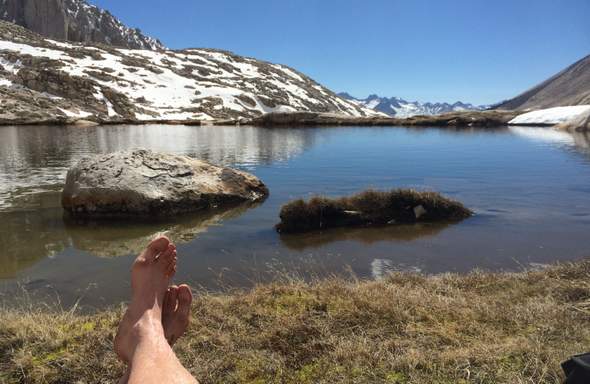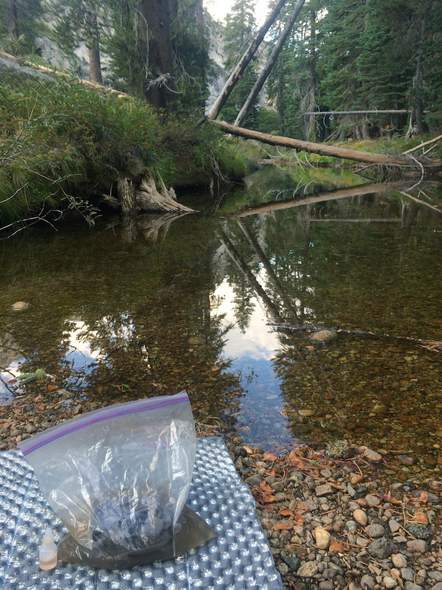Easy Foot Care for Hiking
Sore feet and blisters can be a major problem for both beginning hikers and experienced backpackers. I had never seen so many gnarly blisters, blackened and falling off toenails, or other foot problems as when I was out hiking the Pacific Crest Trail this year. Many of us who had never had blister problems previously on the Appalachian Trail had to change our foot care practices to avoid blisters on the PCT. Fortunately, there are a number of steps to take before your hike and on the trail to promote foot health.

Foot care during a rest break in Yosemite.
Causes of Common Problems
Friction and moisture are the main causes of blisters. On the Pacific Crest Trail, fine sand permeated trail runners and socks, got between toes, and caused abrasion. The heat from the ground in the desert could literally bake your feet. Hot feet also yielded sweaty socks that rubbed against your feet causing blisters. Snow and icy stream crossings in the Sierra left feet cold and constantly wet. All this friction between socks, shoes, and feet can lead to development of blisters.

Drying out my feet in the Sierra
Before the Hike
Prevention of serious foot problems starts before you get on the trail. Learn proper hiking form and pay attention to your gait. Strengthening your feet will go a long way to preventing foot pain (look up exercises for barefoot running for ideas). Get a lightweight pack to lessen the impact on your feet that happens each time you take a step. Find someone at an outdoor or running store who really knows how to fit you in a pair of well-fitting trail shoes and insoles. Non-waterproof trail runners dry more quickly after they get wet, and allow more ventilation. Buy gaiters to prevent sand and dirt from getting into your shoes. Some people swear by thin liner socks layered with thicker socks to reduce friction, others by wool socks or toe socks, while some use just thin men's nylon dress socks. Experiment with different types of socks and find which work best for you. Learn how to treat blisters and tape your feet. It is worth putting in the energy in order to get to know what works well for your feet because everyone is so different.
On the Trail
As you hike, pay extra attention to your feet and give them lots of love. Take a few extra minutes during rest breaks to take off your shoes to allow your feet to cool and your socks to dry out. Inspect your feet to identify potential problems. If you do get a hot spot or blister, bandage it up immediately. Clip long toenails. Some people like to change their socks during the day. But at least shake out the sand and dirt from socks and shoes regularly. If your feet have been wet all day, it is especially important to allow them to dry and heal overnight. Before bed, massage your feet with moisturizing lotion, rash cream, or other water-repellant cream, and change into dry socks. Stretching feet, calves, and achilles also goes far for reducing foot pain and preventing problems.

Applying lotion and changing into clean socks in my hammock before bed
Keeping your socks (relatively) clean is a constant battle, but goes a long way to ensure happy feet. Socks are practically the only thing I carried more than one of. I alternated between two pairs of hiking socks and kept a third pair of warm socks dedicated for sleeping. I washed my dirty socks in a large ziplock, and the dirty wash water was often thick and brown like chocolate milk. If you use a drop of soap to wash your socks, be sure to scatter the wash water 200 feet from streams to keep the water free from contaminants (even if it is biodegradable soap). Then I would hang my socks to dry from my pack as I hiked. Even if you don't have time for a thorough cleaning with soap, a quick rinse of dust and rocks in the water goes a long way!

Washing socks in a ziplock bag
In the desert, the heat of the sand and rocks can cause blisters. Take a break during the heat of the afternoon, and hike when it is cooler. An umbrella can also be used to shade your feet to keep off the heat. Whenever possible, cool your feet in a stream to reduce swelling.
Foot Care Kit
Rather than keeping foot care tools mixed in a first aid kit where they are difficult to find, I kept a dedicated foot care kit in the side pocket of my pack for easy access. Kits vary considerably between people but commonly include scissors or nail clippers, baby wipes or alcohol pads, moisturizer, anti-friction cream, blister pads, antibiotic ointment, and sports tape. I also kept a safety pin for removing splinters, popping painful blisters and for attaching my wet socks to my pack when they were drying.

Basic foot care kit including anti-friction cream, moisturizer, scissors, and tapes
Adjusting to Change
eet happy, the trail will throw something new at you and blisters can spring up all over again. Your feet get bigger so your shoes no longer fit. Long water carries or road-walks put extra pressure on your feet. Or you decide to ignore that hot spot because you want to catch up with your hiking buddy. When feet are ignored, they will demand extra time in the form of soreness or blisters. I know of at least one PCT hiker that had to take a few days off from hiking to let his blisters heal. So take the time to give your feet attention and they will give you many miles of happy hiking.

Airing out our hot feet on a long roadwalk
Written by former Trail Ambassador Joan West and editor - writes as Rambling Hemlock.
